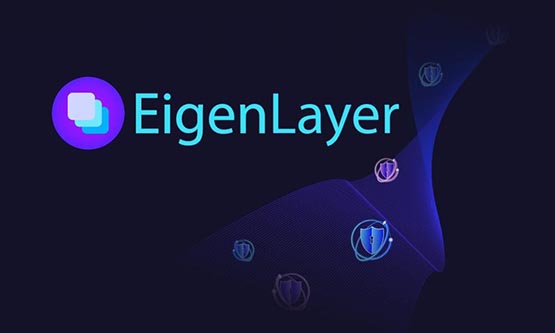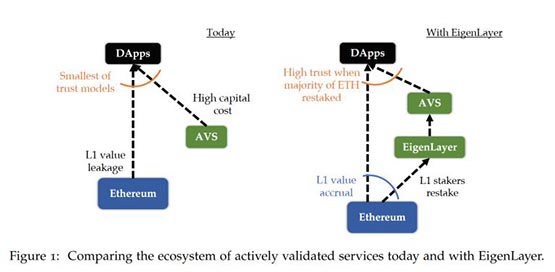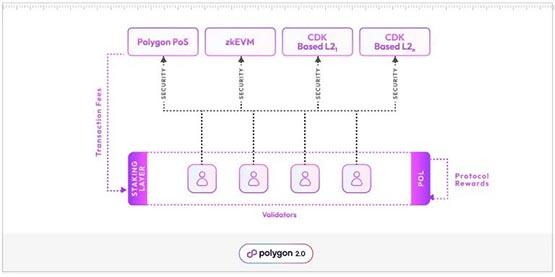Review of other staking protocols (Restaking) except EigenLayer

The restaking protocol (Restaking) is not only featured in the Eigenlayer and Ethereum ecosystems. Crypto researcher Ignas pointed out that rapidly developing restaking protocols have also appeared in ecosystems such as Polygon, Solana, and Cosmos. Pledge project.
Introduction to the concept of re-pledge (Restake)
The concept of re-pledge was proposed by the EigenLayer protocol, which allows users to pledge ETH or stETH to support their nodes to protect the security of the external network. Combining insecure decentralized networks with the security of Ethereum through economically incentivized staking.

EigenLayer seamlessly delivers the security of Ethereum to decentralized infrastructure
There are many examples of decentralized networks that require security from the outside, Examples include projects like Celestia and ChainLink. By combining themselves with the security of Ethereum, they can reduce the difficulty of cold starts with the help of EigenLayer. In addition, there are many sidechain projects that also provide a data availability layer, further enhancing the security of the network. The emergence of these projects means that future decentralized networks no longer need to build security from scratch, but can instead rely on these existing solutions.
The concept of re-pledge extends to multiple ecosystems
In fact, the concept of re-pledge is not original to EigenLayer. Many ecosystems have already had similar projects.
Other ecosystems are also exploring this concept, including future updates of Polygon, Cosmos’ multi-chain ecosystem, Solana’s Picasso project, and Near’s Octopus Network.
Polygon2.0
The Polygon2.0 plan includes providing services for users to pledge new tokens POL to obtain mainnet rewards (POL additional issuance). POL token holders can also stake tokens to support various nodes and run external decentralized networks, forming a multi-chain ecosystem based on the security of the Polygon mainnet.

Polygon2.0 pledge to protect multi-network ecology
In addition to supporting the security of external blockchains, Polygon2.0 is expected to also support aggregation networks , DAO and various other facilities that require security support.
Cosmos
The Cosmos ecosystem originally allows users to stake ATOM tokens to protect networks in other ecosystems. Ignas noted that Neutron is the first network to accept staking of this ATOM for security.
Solana
The Picasso project in the Cosmos ecosystem brings the concept of re-pledge to the Solana network. Users can pledge SOL, mSOL, jitoSOL and other LP tokens to support Solana cross-chain IBC verifiers are expected to be able to extend security to other networks or facilities in the future.
Near
Octopus Network, which supports application chains in the Near ecosystem, has long been a pioneer in the re-staking track. Both users and project teams can pledge NEAR tokens to ensure security. Sexually extended to the application chain on Octopus Network.
Currently the first supported external network on Octopus Network is Ottochain, and more decentralized networks will be supported in the future.
Re-staking is not a new concept
In fact, the concept of re-staking is the same as that of early application chains. However, due to the nature of the pledged assets, you may be able to enjoy multiple benefits. For example, you can get multiple benefits by pledging stETH at the same time. Ethereum consensus rewards and token rewards for potential re-staking projects. So the concept is actually similar, but it's just repackaged by the market.
The concept of re-pledge is not new, but EigenLayer has indeed carried it forward, and combined with the explosive growth in the field of liquid pledged derivatives (LSD) such as Lido in recent years, once again promoted the rationality of the re-pledge narrative.
It can be seen that the currency circle is indeed driven by narrative, which often dazzles the participants. It may not be very healthy from an innovation perspective, but it is undeniable that from a market perspective, the industry has indeed received more attention and development as a result.
As a participant, if you can think from a higher level perspective, you can more clearly identify the real innovation points, and more accurately distinguish the rationality of market ups and downs, which will help you make more accurate judgments. .
The above is the detailed content of Review of other staking protocols (Restaking) except EigenLayer. For more information, please follow other related articles on the PHP Chinese website!

Hot AI Tools

Undresser.AI Undress
AI-powered app for creating realistic nude photos

AI Clothes Remover
Online AI tool for removing clothes from photos.

Undress AI Tool
Undress images for free

Clothoff.io
AI clothes remover

Video Face Swap
Swap faces in any video effortlessly with our completely free AI face swap tool!

Hot Article

Hot Tools

Notepad++7.3.1
Easy-to-use and free code editor

SublimeText3 Chinese version
Chinese version, very easy to use

Zend Studio 13.0.1
Powerful PHP integrated development environment

Dreamweaver CS6
Visual web development tools

SublimeText3 Mac version
God-level code editing software (SublimeText3)

Hot Topics
 Free viewing market software websites What are the top ten free viewing market software websites
Apr 24, 2025 pm 02:21 PM
Free viewing market software websites What are the top ten free viewing market software websites
Apr 24, 2025 pm 02:21 PM
Top 10 free-to-view market software websites are recommended: 1. Binance, 2. OkX, 3. Sesame Open Door (KuCoin), 4. CoinMarketCap, 5. CoinGecko, 6. TradingView, 7. Investing.com, 8. Yahoo Finance, 9. Glassnode Studio, 10. LunarCrush, these websites provide real-time data, technical analysis tools and market information to help you make informed investment decisions.
 Ranking of the top ten virtual currency exchange platforms in the 2025 currency circle
Apr 24, 2025 pm 01:57 PM
Ranking of the top ten virtual currency exchange platforms in the 2025 currency circle
Apr 24, 2025 pm 01:57 PM
The forecast rankings of the top ten virtual currency exchange platforms in the 2025 cryptocurrency exchange platforms: 1. Binance, 2. Coinbase, 3. Ouyi, 4. Kraken, 5. Sesame Open, 6. Bybit, 7. Bitget, 8. Huobi, 9. Gate.io, 10. MEXC Matcha Exchange, these platforms are expected to stand out in future competition due to their advantages in compliance, security, user experience, transaction depth, user scale, innovation ability and transaction fees.
 2025 Most Complete Exchange Ranking 2025 Virtual Currency Exchange Ranking
Apr 24, 2025 pm 01:48 PM
2025 Most Complete Exchange Ranking 2025 Virtual Currency Exchange Ranking
Apr 24, 2025 pm 01:48 PM
The top ten mainstream virtual currency exchanges in the world in 2025 are: 1. Binance, 2. Ouyi, 3. Bybit, 4. Coinbase, 5. Sesame Open, 6. Bitget, 7. Kraken, 8. MEXC, 9. KuCoin, 10. Bitfinex. These exchanges have outstanding performance in terms of trading volume, user experience, security, compliance and market influence, and are suitable for investors with different needs.
 A detailed introduction to virtual currency is a must-read for novices
Apr 24, 2025 pm 01:33 PM
A detailed introduction to virtual currency is a must-read for novices
Apr 24, 2025 pm 01:33 PM
Virtual currency is a digital asset encrypted using cryptography technology, with its main features including decentralization, encryption security, global circulation and relative anonymity. Virtual currency has a wide range of application scenarios, including value storage, trading media, investment and financial management, DeFi, NFT, blockchain games, smart contracts, dApps and governance voting. Participating in virtual currency requires 1) Learn basic knowledge, 2) Select a trading platform, 3) Register and verify your identity, 4) Purchase virtual currency, 5) Safely store, 6) Participate in the community. Investments need to pay attention to risks such as price fluctuations, market, technology, supervision, fraud and information asymmetry.
 Bian download tutorial Bian latest version download tutorial
Apr 24, 2025 pm 12:36 PM
Bian download tutorial Bian latest version download tutorial
Apr 24, 2025 pm 12:36 PM
The steps to download the latest version of Bian are as follows: 1. Visit the official website of Bian. 2. Select the appropriate version (Windows, macOS, Linux). 3. Download the installation package. 4. Double-click the installation package and follow the prompts to install. 5. Enter the activation code and configure the settings. 6. Regularly update and scan the system to ensure safety.
 The best free virtual currency exchange in the world Free newbie virtual currency exchange app
Apr 24, 2025 pm 12:57 PM
The best free virtual currency exchange in the world Free newbie virtual currency exchange app
Apr 24, 2025 pm 12:57 PM
The best free virtual currency exchanges in the world are Binance, OKX and Gate.io. 1. Binance provides an efficient trading system and rich trading pairs, simple registration, and supports multiple cryptocurrency transactions. 2. OKX is famous for its technical support and customer service, and provides a variety of transaction methods. 3. Gate.io attracts newbies with rich trading pairs and free services, with a simple interface and supports multiple languages.
 What are the next thousand-fold coins in 2025?
Apr 24, 2025 pm 01:45 PM
What are the next thousand-fold coins in 2025?
Apr 24, 2025 pm 01:45 PM
As of April 2025, seven cryptocurrency projects are considered to have significant growth potential: 1. Filecoin (FIL) achieves rapid development through distributed storage networks; 2. Aptos (APT) attracts DApp developers with high-performance Layer 1 public chains; 3. Polygon (MATIC) improves Ethereum network performance; 4. Chainlink (LINK) serves as a decentralized oracle network to meet smart contract needs; 5. Avalanche (AVAX) trades quickly and
 The latest entrance to the Ouyi Exchange 2025 Where is the latest entrance to the Ouyi Exchange
Apr 24, 2025 pm 12:48 PM
The latest entrance to the Ouyi Exchange 2025 Where is the latest entrance to the Ouyi Exchange
Apr 24, 2025 pm 12:48 PM
The latest access methods of Ouyi Exchange: 1. Enter the official website; 2. Click the "Latest Entrance" button; 3. Log in or register an account; 4. Start trading. This portal improves security and access speed and supports multilingual.





